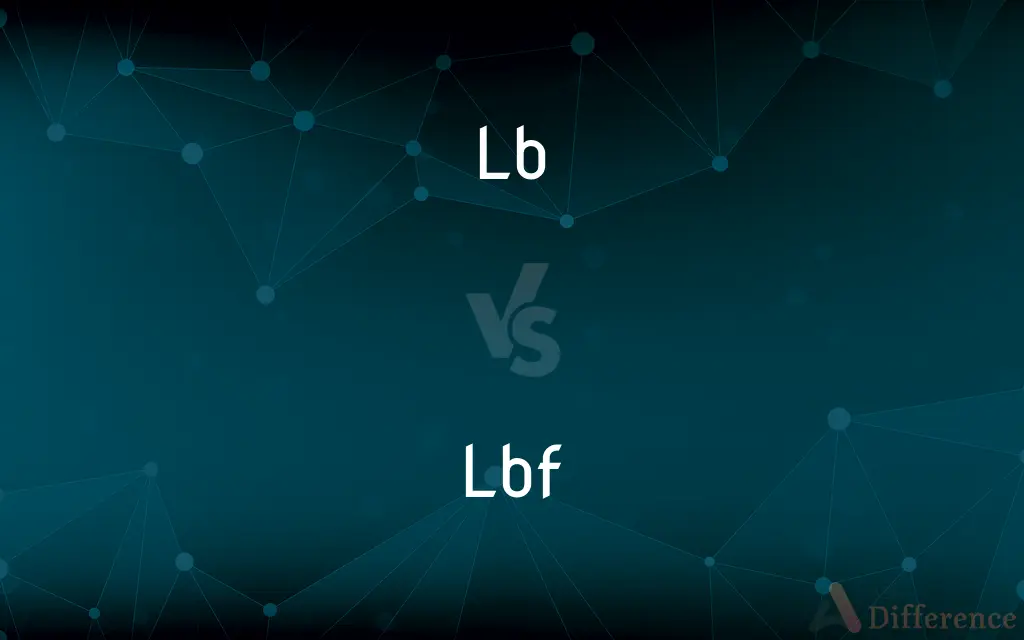Lb vs. Lbf — What's the Difference?
"Lb" refers to the pound as a unit of mass within the imperial and US customary systems. "Lbf" stands for pound-force and measures force, representing the gravitational force exerted on a mass of one pound on the surface of the Earth.

Difference Between Lb and Lbf
Table of Contents
ADVERTISEMENT
Key Differences
The distinction between "lb" (pound) and "lbf" (pound-force) is fundamental in physics and engineering, highlighting the difference between mass and force. Mass, measured in pounds, quantifies the amount of matter in an object, independent of gravity. Force, measured in pound-force, quantifies the push or pull on an object due to gravity or other factors.
The pound (lb) is part of the imperial and US customary systems, used widely in the United States for measuring weight, which is technically a mass measurement. The pound-force (lbf), however, explicitly measures force, including the effect of Earth's gravity on a mass. One pound-force is defined as the force required to accelerate a mass of one pound at a rate of 32.17405 feet per second squared, the standard acceleration due to Earth's gravity.
In practice, when people refer to weight in pounds (lb), they are often discussing mass but implying the gravitational force acting on that mass (weight). For scientific, engineering, and technical purposes, distinguishing between lb and lbf clarifies whether the measurement pertains to mass (lb) or the force due to gravity on that mass (lbf).
Comparison Chart
Definition
Unit of mass
Unit of force
System
Imperial and US customary
Imperial and US customary
ADVERTISEMENT
Used to Measure
Quantity of matter in an object
Gravitational force exerted on a mass
Standard Gravity
N/A
32.17405 ft/s² (acceleration due to Earth's gravity)
In Physics
Mass is constant regardless of location
Force varies with the gravitational field strength
Common Usage
Often used interchangeably with weight
Specifies force, especially in engineering and science
Compare with Definitions
Lb
Weight measurement.
The package weighs 10 lb, referring to its mass under Earth's gravity.
Lbf
Unit of force.
The engine generates 400 lbf of thrust, indicating its force output.
Lb
Constant quantity.
A 2 lb steak has the same mass, regardless of being on Earth or the Moon.
Lbf
Engineering use.
Structural loads are calculated in lbf to ensure safety under gravity.
Lb
Unit of mass.
He purchased 5 lb of coffee beans, indicating the quantity of matter.
Lbf
Gravity dependent.
A 180 lbf person experiences less force on the Moon than on Earth.
Lb
16 ounces;
He tried to lift 100 pounds
Lbf
Specific measurement.
The spring's tension was measured to be 50 lbf, indicating the force it exerts.
Lb
Imperial system.
In the US, body weight is commonly measured in lb.
Lbf
Pound-force (unit of force)
Lb
A pound (unit of weight).
Common Curiosities
Is there a metric equivalent to lbf?
Yes, the metric equivalent to pound-force is the newton (N); 1 lbf is approximately equal to 4.44822 N in the International System of Units (SI).
Why is it important in engineering to use lbf?
Engineers use lbf to accurately describe forces, such as tension, friction, and weight, ensuring structures and mechanisms are designed to handle these forces correctly.
How does gravity affect lb and lbf measurements?
The lb (mass) remains constant regardless of gravity, while the lbf (force) varies with the gravitational field strength.
How do I convert lb to lbf?
For practical purposes on Earth, 1 lb mass is often considered to weigh 1 lbf due to Earth's gravity. For scientific accuracy, conversion involves the acceleration due to gravity, with 1 lbf defined as the force required to accelerate a 1 lb mass at 32.17405 ft/s².
How do lb and lbf relate to daily life applications?
Daily life often involves lb for mass (e.g., buying groceries) and lbf for force (e.g., the force needed to lift a heavy object), though people commonly refer to both simply as pounds without distinction.
Can the values of lb and lbf be numerically equivalent?
On Earth's surface, the weight (force due to gravity) of a 1 lb mass is approximately 1 lbf, making the numbers equivalent in common usage, though they measure different physical quantities.
Are lb and lbf used internationally?
While lb is widely used in the United States and to a lesser extent in other countries for mass, lbf is primarily used in specific fields like engineering and science, predominantly in the US. Many countries use the metric system, where kilograms (kg) and newtons (N) serve similar functions.
Why differentiate between lb and lbf?
Differentiating clarifies whether you're referring to the mass of an object (lb) or the force acting on that mass due to gravity (lbf), important in precise scientific and engineering contexts.
What is the significance of standard gravity in defining lbf?
Standard gravity is crucial for defining lbf because it provides a consistent reference for the force of gravity, allowing for uniform calculations and comparisons of force in engineering and scientific contexts.
How do lb and lbf impact the design of buildings and structures?
Engineers and architects use lb to calculate materials' mass for transportation and handling, and lbf to ensure structures can withstand environmental forces like wind, snow, and the weight of occupants and furnishings safely.
Can lb and lbf measurements affect medical dosages or equipment?
In medicine, lb is used to gauge patient mass for medication dosages and dietary needs, while lbf can apply to the force applied by medical devices, such as compression machinery or orthopedic supports, ensuring patient safety and efficacy.
How does the distinction between lb and lbf enhance scientific research?
Accurate distinction allows researchers to precisely measure and report forces and masses, critical for experiments in fields ranging from particle physics to materials science, ensuring reproducibility and validity of findings.
What happens to lb and lbf measurements in space?
In the microgravity environment of space, a mass measured in lb retains its value, but the force it exerts (lbf) dramatically decreases, affecting how astronauts perceive weight and handle objects.
How do manufacturers use lb and lbf in product specifications?
Manufacturers use lb to specify the mass of a product and lbf to describe the maximum force it can withstand or exert, crucial for ensuring products meet safety and performance standards.
How do lb and lbf affect athletic performance?
In sports, understanding the difference helps athletes and coaches measure performance accurately, considering lb for body mass and muscle mass, and lbf for the force generated during activities like lifting, throwing, or jumping.
What educational concepts help distinguish lb from lbf?
Education in physics and engineering emphasizes the distinction through the study of Newton's laws of motion, gravitational theory, and units of measurement, fostering a clear understanding of mass versus force.
Are there historical reasons for the confusion between lb and lbf?
Historically, the distinction was less emphasized in everyday life, with the term "pound" used interchangeably. As science and technology advanced, the need for precision in measurements necessitated clearer distinctions.
What future trends might affect the use of lb and lbf?
Globalization and the increasing adoption of the metric system might lead to a gradual decrease in the use of lb and lbf, with SI units becoming more prevalent in education, industry, and commerce for international consistency and simplicity.
Why might someone prefer to use lb over kilograms or vice versa?
Preference often depends on cultural and educational background; those in the US and parts of the UK might prefer lb for familiarity, while those in countries using the metric system might favor kilograms for international consistency and scientific precision.
What role do lb and lbf play in vehicle performance specifications?
Vehicle performance can be described using lb for the vehicle's mass (affecting acceleration, fuel efficiency) and lbf for aspects like engine thrust, brake force, or the structural load capacity.
Share Your Discovery

Previous Comparison
Earphones vs. Headphones
Next Comparison
Corona vs. Modelo















































